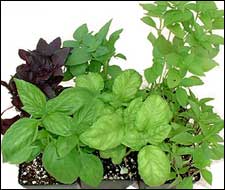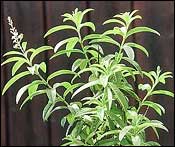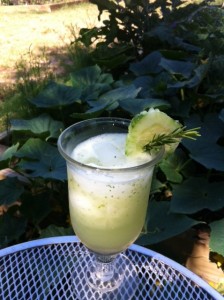 AnnualCulinary, Ornamental AnnualCulinary, Ornamental
2 to 2-1/2 feet high, 2 feet wide
Full Sun
Prefers well-drained soil |
We wrote about Basil in July of 2005 – but it is such a wonderful Herb we thought we would bring it to your attention again – enjoy!Basil, Ocimum basilicumIf you like basil, one pot of it won’t be enough. And each pot can house a different variety, with about 150 varieties available. The large selection is due to the range of essential oils that give basils their characteristic fragrances. In most instances their fragrance and flavor difference is distinct. Sometimes flavors vary between each plant’s leaves, flowers and seeds. |
For gardeners and cooks, fresh, aromatic basil leaves are one of the most indispensable flavors. Basil is a traditional companion plant with tomatoes. Some gardeners believe basil helps keep tomato plants free from insects, and imparts a richer flavor to the tomato fruits.
Best of the Basils
Sweet Basil — This is the most commonly known, and its large green leaves have a sweeter, more delicate flavor than many basils. A gourmet necessity for tomatoes and garlic, it’s the one preferred for pesto. Of several strains, three are often recommended:
Basil napolentano has large, light green leaves, with a mellow-sweet aroma and rich, buttery flavor. A great appetizer wrapper.
Basil genova profumatissima has long, pointed, shiny leaves with a distinctively strong perfume flavor. This one is the most prolific leaf producer.
Basil fino verde compatto has thick clusters of sweet mini-leaves that cause it to look more like a pretty shrub. Its 12-inch height make it the most suitable for containers or with low growing flowers in a border.
Lemon Basil — Shrubbier, to 2 feet high and 2 feet wide, with longer white flowering spikes than other types. Its delicate pale-green leaves have a pronounced citrus scent, making it a pucker-up favorite for fish, vegetables and pasta. Combine it with mint to create a delicious iced libation. Refreshing in potpourri.
Cinnamon Basil — An attractive purplish plant to 2 feet high. Glossy leaves and pink flower spikes have a definite herb and spice fragrance. We devour it in sweets with toasted pecans or fresh fruits, as well as in savory chicken and seafood dishes.
Anise Basil — Any tomato-based dish that would benefit from the flavor of fennel can be accommodated by this licorice like basil. Add a touch of Asian mystery to mild vegetables such as squash, potatoes and eggplant with a minced fresh leaf or creamy flower cluster.
Purple (Opal) Basil — Has a bite that’s as intense as its purple leaf color. It’s too sharp for many palates, yet for those with a preference for the robust, add as a light garnish to pasta, seafood or poultry. Its deep purple leaves lend an amethyst cast to basil vinegar, oil or jelly. It’s also a dramatic filler in a bouquet of bright flowers.
Holy (Perfume) Basil — Sacred to the Hindus, who use it in their religious ceremonies. Its free-spirited growth causes it to become lanky, so don’t delay controlling it. The jagged leaves are coarse and sweet smelling. Add sparingly to fruits, jellies and breads, as well as to potpourris. Its essential oil often refines luxury fragrances and soaps.
Lettuce-Leaf Basil — Looking more like a mounded, 18 inch salad bowl in the garden, this basil’s shiny, crinkled, 4-inch leaves and greenish white blossoms define a true kitchen herb. Use to wrap cheeses, rice melanges, grilled mini-meat cuts and vegetables.
Spicy Globe Basil — A superior landscape selection. Minimal clipping required to keep its compact sphere shape. Decorate as a low border or plant in a pot. This basil adds soft fragrance to a garden.
Planting & Care.
Seeds germinate quickly — usually 7 to 10 days after planting in rich, moist warm soil. Basil do best in full sun when day and night temperatures are above 60 degrees F. If grown indoors in a sunny south window, basils make handsome fragrant house plants.
Basils are usually classified as annuals. New plants are germinated from seed. However, in mild, frost-free climates such as Hawaii, a basil plant can develop into a semi-woody perennial shrub.
Harvesting and Use.
Basil is a vigorous herb, producing abundant leaves. For the best flavor and to prolong its productive season, pinch off blossoms as soon as they appear.
The smell of basil is said to be “good for the heart and the head,” so we recommend including it in more than spaghetti sauce. Basil lends an unforgettable spicy flavor and aroma to herb butters and vinegars.
A basil tea is claimed to quiet the nerves. Add basil stems and flower stalks to stews and soups. Throw basil stalks on the coals when grilling for a wonderful, permeating aroma. The sweet flowers can be used to make a delicious marinade.
To preserve basil, bundle sprays together and hang-dry in a dark place, or wrap individual stalks and freeze in plastic bags or seal in plastic containers.










